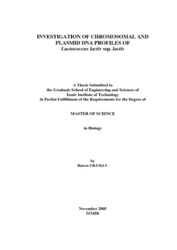Please use this identifier to cite or link to this item:
https://hdl.handle.net/11147/3300| Title: | Investigation of chromosomal and plasmid dna profiles of lactococcus lactics ssp. lactis | Authors: | Okuklu, Burcu | Advisors: | Güneş, Hatice | Publisher: | Izmir Institute of Technology | Abstract: | Lactic acid bacteria used in the manufacturing of cheese and other fermented milk products are known as starter cultures. Starters play an important role in the sensory properties of fermented milk products by lactic acid production which influences desirable quality characteristics. In dairy industry, diversity of starter strains of Lactococcus lactis is very limited. There is a considerable demand for novel starters with technologically desirable properties. Gene products responsible for lactose fermentation are encoded on plasmid DNA. Therefore, the plasmid stability of lactic acid bacteria is an important industrial property for starter culture. In the previous study, Lc. lactis ssp. lactis strains were isolated from an artisanal "comlek peyniri'" from Cappodocia and these strains were selected as good acid producers. The aim of this study was to investigate intraspecific diversity of 54 Lc. lactis ssp. lactis by choromosomal and plasmid profiling. In addition, the plasmid stability of 35 artisanal starters was determined by the examination -galactosidase activity. First of all, partial DNA sequencing of the 16S rRNA genes was carried out in order to confirm that the previously identified isolates were Lc. lactis ssp. lactis. The partial DNA sequencing and blast search results indicated that representative isolates showed 90 % homology with Lactococcus lactis. Based on chromosome and plasmid profiling results, 35 Lactococcus lactis artisanal starters exhibiting good acidifying activities were classified into ten different genotypes and nine plasmid groups. None of the reference strains of Lactococcus lactis ssp. lactis and Lc. lactis ssp. cremoris and Lc. lactis ssp. lactis biovar. diacetylactis were included into these genotypes and plasmid groups. The rest of the 17 isolates which were defined as low acid producers by technological methods were clustered into thirteen unique genotypes and seven plasmid groups. Only four of the isolates were found to contain the most stable plasmids by instability studies and these kept their lactase activities during prolonged subculturing. As a result, chromosome and plasmid DNA profiling allowed us to classify artisanal starter strains in certain groups. The strains with stable and instable plasmids will serve us to characterize and improve technological features of these artisanal starter strains in future studies. | Description: | Thesis (Master)--İzmir Institute of Technology, Molecular Biology and Genetics, İzmir, 2005 Includes bibliographical references (leaves: 58-63) Text in English; Abstract:Turkish and English xi, 79 leaves |
URI: | http://hdl.handle.net/11147/3300 |
| Appears in Collections: | Master Degree / Yüksek Lisans Tezleri |
Files in This Item:
| File | Description | Size | Format | |
|---|---|---|---|---|
| T000396.pdf | MasterThesis | 1.71 MB | Adobe PDF |  View/Open |
CORE Recommender
Page view(s)
152
checked on Nov 18, 2024
Download(s)
104
checked on Nov 18, 2024
Google ScholarTM
Check
Items in GCRIS Repository are protected by copyright, with all rights reserved, unless otherwise indicated.